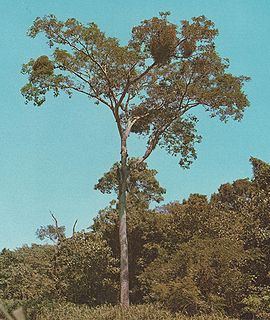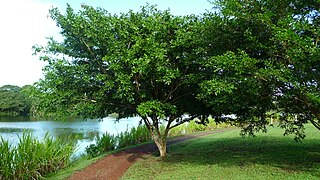
Albizia is a genus of more than 160 species of mostly fast-growing subtropical and tropical trees and shrubs in the subfamily Mimosoideae of the family Fabaceae. The genus is pantropical, occurring in Asia, Africa, Madagascar, America and Australia, but mostly in the Old World tropics. In some locations, some species are considered weeds.

Abarema is a neotropical genus of large trees in the legume family (Fabaceae). They grow from Mexico to Bolivia. Most of the species can be found in the Amazon Basin and the Guyana Highlands. They have a deep-green fernlike foliage, with bipinnately compound leaves.

Pithecellobium dulce, commonly known as Manila tamarind, Madras thorn, or camachile, is a species of flowering plant in the pea family, Fabaceae, that is native to the Pacific Coast and adjacent highlands of Mexico, Central America, and northern South America. It is also sometimes known as monkeypod, but that name is also used for several other plants, including Samanea saman. It is an introduced species and extensively naturalized in the Caribbean and Florida, as well as the Philippines and Guam via the Manila galleons. It has also been introduced to Thailand and South Asia, It is considered an invasive species in Hawaii.

Albizia lebbeck is a species of Albizia, native to Indomalaya, New Guinea and Northern Australia and widely cultivated and naturalised in other tropical and subtropical regions. English names for it include lebbeck, lebbek tree, flea tree, frywood, koko and woman's tongue tree. The latter name is a play on the sound the seeds make as they rattle inside the pods. Being one of the most widespread and common species of Albizia worldwide, it is often simply called siris, though this name may refer to any locally common member of the genus.

Albizia inundata is a perennial tree native to South America. Common names include maloxo, muqum, paloflojo, timbo blanco, timbo-ata, and also "canafistula" though this usually refers Cassia fistula.

Havardia albicans is a perennial tree of the family Fabaceae that grows to 5 meters tall. It is native to Mexico, the Caribbean and Central America, in regions around the Yucatan Peninsula. Common names for it include chucum and cuisache. It is reputed to be psychoactive.
Albizia pistaciifolia is a species of plant in the family Fabaceae. It is found in Colombia, Ecuador, and Venezuela.
Hesperalbizia occidentalis is a species of plant in the family Fabaceae. As a native plant it is found only in Mexico, where it is endangered by deforestation. It has been introduced to Honduras.
Chloroleucon foliolosum is a tree species in the legume family (Fabaceae). It is found in Argentina, Brazil and Bolivia.
Pithecellobium pithecolobioides, known as Granadillo de Río, is a tree species in the legume family (Fabaceae).
Abarema glauca is a tree species in the legume family (Fabaceae). It is found in Cuba, Dominican Republic, and Venezuela. Common rural names are: caracolí, nijaguao, paují (Pittier), jijaguao, and merey montañero (Hoyos). Abarema glauca is found most easily on the east coast of Dominican Republic, in Uvero Alto, north of Punta Cana..
Zygia cognata is a tree species in the legume family (Fabaceae). It is found in Belize, Guatemala, and Honduras.

Platymiscium is a genus of legume in the family Fabaceae, and was recently assigned to the informal monophyletic Pterocarpus clade within the Dalbergieae. It has a Neotropical distribution, from northern Mexico to southern Brazil. Platymiscium is the only genus in the family with opposite leaves in all its species. Its wood has various uses, mostly for constructions and furniture.

Zygia is a genus of flowering plants in the pea family, Fabaceae.

Archidendron bigeminum is a tree species in the legume family (Fabaceae). It is found in India and Sri Lanka. It is known as "Kalitiya - කලටිය" in Sinhala people.
Abarema alexandri is a species of legume of the genus Abarema in the family Fabaceae. It is endemic to Jamaica, where it can be found in woodland or thicket on limestone soils.
Abarema alexandri var. troyana is a variety of the legume A. alexandri in the family Fabaceae. It is endemic to Jamaica, where it can be found in woodland or thicket on limestone soils.









